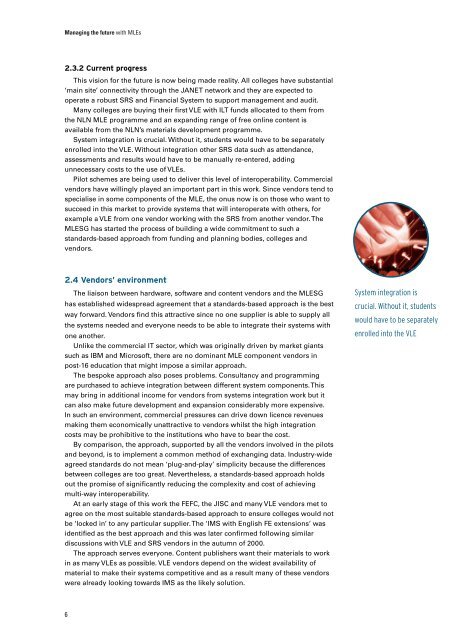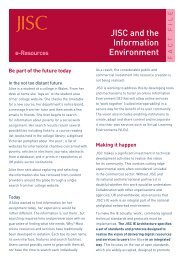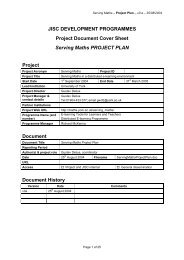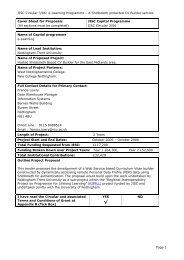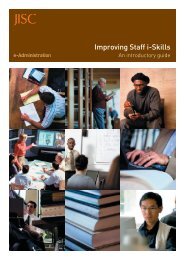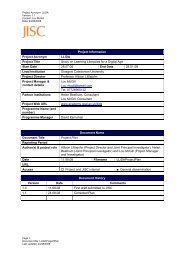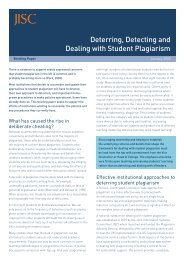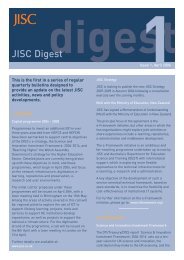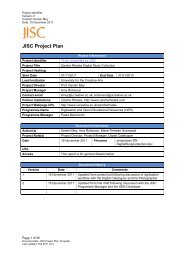Managing the future with MLEs - Jisc
Managing the future with MLEs - Jisc
Managing the future with MLEs - Jisc
You also want an ePaper? Increase the reach of your titles
YUMPU automatically turns print PDFs into web optimized ePapers that Google loves.
<strong>Managing</strong> <strong>the</strong> <strong>future</strong> <strong>with</strong> <strong>MLEs</strong><br />
2.3.2 Current progress<br />
This vision for <strong>the</strong> <strong>future</strong> is now being made reality. All colleges have substantial<br />
‘main site’ connectivity through <strong>the</strong> JANET network and <strong>the</strong>y are expected to<br />
operate a robust SRS and Financial System to support management and audit.<br />
Many colleges are buying <strong>the</strong>ir first VLE <strong>with</strong> ILT funds allocated to <strong>the</strong>m from<br />
<strong>the</strong> NLN MLE programme and an expanding range of free online content is<br />
available from <strong>the</strong> NLN’s materials development programme.<br />
System integration is crucial. Without it, students would have to be separately<br />
enrolled into <strong>the</strong> VLE. Without integration o<strong>the</strong>r SRS data such as attendance,<br />
assessments and results would have to be manually re-entered, adding<br />
unnecessary costs to <strong>the</strong> use of VLEs.<br />
Pilot schemes are being used to deliver this level of interoperability. Commercial<br />
vendors have willingly played an important part in this work. Since vendors tend to<br />
specialise in some components of <strong>the</strong> MLE, <strong>the</strong> onus now is on those who want to<br />
succeed in this market to provide systems that will interoperate <strong>with</strong> o<strong>the</strong>rs, for<br />
example a VLE from one vendor working <strong>with</strong> <strong>the</strong> SRS from ano<strong>the</strong>r vendor. The<br />
MLESG has started <strong>the</strong> process of building a wide commitment to such a<br />
standards-based approach from funding and planning bodies, colleges and<br />
vendors.<br />
2.4 Vendors’ environment<br />
The liaison between hardware, software and content vendors and <strong>the</strong> MLESG<br />
has established widespread agreement that a standards-based approach is <strong>the</strong> best<br />
way forward. Vendors find this attractive since no one supplier is able to supply all<br />
<strong>the</strong> systems needed and everyone needs to be able to integrate <strong>the</strong>ir systems <strong>with</strong><br />
one ano<strong>the</strong>r.<br />
Unlike <strong>the</strong> commercial IT sector, which was originally driven by market giants<br />
such as IBM and Microsoft, <strong>the</strong>re are no dominant MLE component vendors in<br />
post-16 education that might impose a similar approach.<br />
The bespoke approach also poses problems. Consultancy and programming<br />
are purchased to achieve integration between different system components. This<br />
may bring in additional income for vendors from systems integration work but it<br />
can also make <strong>future</strong> development and expansion considerably more expensive.<br />
In such an environment, commercial pressures can drive down licence revenues<br />
making <strong>the</strong>m economically unattractive to vendors whilst <strong>the</strong> high integration<br />
costs may be prohibitive to <strong>the</strong> institutions who have to bear <strong>the</strong> cost.<br />
By comparison, <strong>the</strong> approach, supported by all <strong>the</strong> vendors involved in <strong>the</strong> pilots<br />
and beyond, is to implement a common method of exchanging data. Industry-wide<br />
agreed standards do not mean ‘plug-and-play’ simplicity because <strong>the</strong> differences<br />
between colleges are too great. Never<strong>the</strong>less, a standards-based approach holds<br />
out <strong>the</strong> promise of significantly reducing <strong>the</strong> complexity and cost of achieving<br />
multi-way interoperability.<br />
At an early stage of this work <strong>the</strong> FEFC, <strong>the</strong> JISC and many VLE vendors met to<br />
agree on <strong>the</strong> most suitable standards-based approach to ensure colleges would not<br />
be ‘locked in’ to any particular supplier. The ‘IMS <strong>with</strong> English FE extensions’ was<br />
identified as <strong>the</strong> best approach and this was later confirmed following similar<br />
discussions <strong>with</strong> VLE and SRS vendors in <strong>the</strong> autumn of 2000.<br />
The approach serves everyone. Content publishers want <strong>the</strong>ir materials to work<br />
in as many VLEs as possible. VLE vendors depend on <strong>the</strong> widest availability of<br />
material to make <strong>the</strong>ir systems competitive and as a result many of <strong>the</strong>se vendors<br />
were already looking towards IMS as <strong>the</strong> likely solution.<br />
System integration is<br />
crucial. Without it, students<br />
would have to be separately<br />
enrolled into <strong>the</strong> VLE<br />
6


